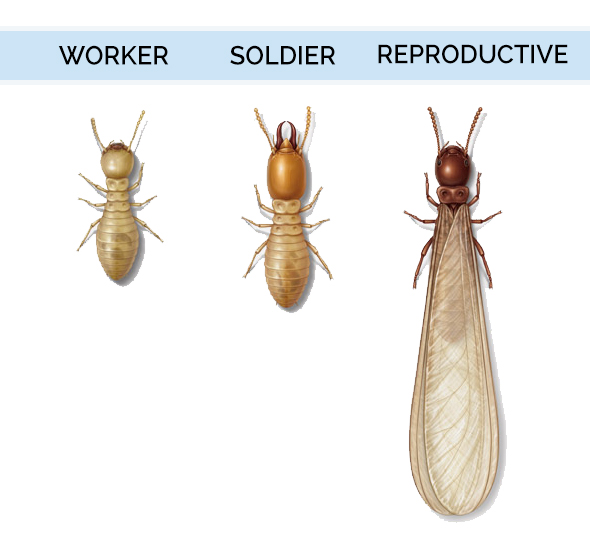Termites are insects that eat wood, which can lead to the destruction of furniture, homes, and other wooden structures. Termites come in two varieties, drywood and subterranean, and both are often confused with ants.
It is important to determine what type of termites you have as the termite treatment process for drywood and subterranean termites are very different. Use this guide to determine what type of termites you have.
If you suspect you might have ants instead of termites, take a look at our Ant Control Guide for more information.
Click a topic below to quickly jump to one of the different ways to identify drywood termites, or continue reading to learn more about them.
Termites vs. Ants

- Termites have thick waists while ants have noticeably small waists.
- Termites have straight antennae while ants have clubbed or bent antennae.
- Termites have short legs while ants have longer legs.
- When termites have wings, all wings will be the same length. When ants have wings, the front wings are longer than the back wings.
Once you have determined that you are indeed dealing with termites instead of ants, you will need to figure out what type of termites you have. It can be difficult to identify the type of termite you have by looking at the insect itself. Instead, it is much easier to identify the kind of termites you have by the damage they cause.
Drywood vs. Subterranean Termites

Drywood Termites:
- Drywood termites do not require soil contact
- Drywood termites have protruding mouth pinchers
- Drywood termites nest inside of the wood they are infesting
- Drywood termites do not make mudtubes
- Drywood termites can fly into structures to infest the wood
- Drywood termites make small "kickout" holes in wood to push feces and debris out of the nest
- Drywood termites leave small piles of debris outside of the infested wood
- Drywood termites usually eat across and along the grain of the wood
- Drywood termites are usually found in coastal regions but they can be transported to other regions in infested wood (usually when a piece of furniture is moved)
Subterranean Termites:
- Subterranean termites have the main portion of their nest underground
- Subterranean termites make mud tubes to access structures
- Subterranean termites usually have large colonies
- Subterranean termites do not kick out feces and debris
- Subterranean termites typically eat along the grain of the wood
- Subterranean termites are known to make "carton" nests in wall voids and in trees. A carton is a nest made from the termite fecal matter to maintain the correct moisture level when the termites are unable to return to the actual subterranean nest.
If you have subterranean termites, read our Subterranean Termite Control Guide. If you have drywood termites, continue reading this guide.
Drywood termites have a thick waist, short legs, and straight antennae. Drywood termite swarmers, also known as alates, have wings that are the same length. Termite soldiers have mouthparts (mandibles) with teeth.
Drywood termites vary in color depending on their maturity and role within the colony. Worker termites are cream colored and can look white against wood. Soldier termites range from cream to brown. Alates, also known as reproductive or swarmer drywood termites, can be brown or black in color.
Drywood termites are often found in southern coastal areas across the United States.








